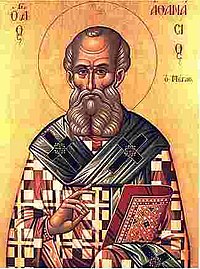Below, an abridged translation from the first volume of Karlheinz Deschner’s Kriminalgeschichte des Christentums (Criminal History of Christianity). For a single online book that explains the importance of the subject of the destruction of the Greco-Roman world by Judeo-Christians, see here. In a nutshell, any white person who worships the god of the Jews is, ultimately, ethno-suicidal.
The ‘battlefield’ of Alexandria
 The departure of Athanasius in June from Trier, the city of the West that had received him triumphantly and had treated him in an extraordinary way, was the first act of the government of Constantine II.
The departure of Athanasius in June from Trier, the city of the West that had received him triumphantly and had treated him in an extraordinary way, was the first act of the government of Constantine II.
During the long trip back, the repatriated Athanasius took the opportunity to establish peace in his own way in Asia Minor and Syria, that is, helping Catholics to regain power. For that reason, after his campaign, ‘anti-bishops’, discord and new splits appeared everywhere. ‘Where there were anti-bishops there were regular riots and street fights, after which the pavement was covered with hundreds of corpses’ (Seeck).
When the remaining exiles returned to their homeland, orthodoxy flourished everywhere.
In the first place, the churches stained by the ‘heretics’ were thoroughly cleaned, although not always with sea water, as the Donatists did. These Catholic bishops practiced more drastic customs. In Gaza, the supreme pastor Asclepius had the ‘desecrated’ altar destroyed. In Akira, Bishop Marcellus tore from his adversaries their priestly garments, hung the ‘debased’ hosts around their necks and threw them out of the church. In Hadrianopolis, Bishop Lucius fed the dogs with the Eucharistic bread and, later, when they returned, he denied communion to the eastern participants of the Synod of Serdica, provoking even the population of the city against him.
The first official act, so to speak, of the repatriated Athanasius at the end of November of the year 337 was to interrupt the supply of grain (destined by the emperor to feed the poor, all the supporters of his opponent) to appease with the surplus the new members of his Praetorian guard.
In mid-March of 339 Athanasius fled to Rome with a criminal complaint on his back, addressed to the three emperors and accusing him of new ‘murders’. (However, now he could not use the imperial courier as he used to do in his exile and travels; he travelled by sea.) His people burned the church of Dionysus, the second ‘divine temple’ in terms of Alexandria’s size, so that he could escape at least from the profanation.
While with the help of the State, Bishop Gregory exercised a strict command, Athanasius, with other deposed Church princes, settled in Rome at the side of Bishop Julius I who, with almost the entire West, favoured the Nicene Council. For the first time in the history of the Church, prelates excommunicated by oriental synods obtain their rehabilitation in a Western episcopal tribunal. The only ones we know with certainty are Athanasius and Marcellus of Akira, the profaner of clerics and hosts mentioned above.
After demonstrating his ‘orthodoxy’ Julius I admitted them, along with the remaining fugitives, into the fellowship of his church. And it is here, in Rome and in the West, that Athanasius acquires a decisive importance for his politics of power; where he works towards ‘a schism of the two halves of the Empire’ (Gentz), which is embodied in the year 343 in the Synod of Serdica.
The Arians, furious at the intrusion of Rome, ‘surprised to a great degree’, as stated in the manifesto they presented in Serdica, excommunicate Bishop Julius I: ‘the author and ringleader of evil’. And while Athanasius incites the spirits and serves for his ’cause’ in one of the halves of the Empire against the other, so that the struggle for the power of this Alexandrian bishop becomes the struggle for power in Rome, religiosity reaches culminating peaks in the East.
2 replies on “Kriminalgeschichte, 49”
I have read this by the way. If I were to link this on a WN forum/blog, which shall it be in your opinion?
Linking an isolated entry like Krim-49 wouldn’t make sense out of context. But now that Soberana’s PDF is ready, it would be possible, when talking to WN normies, at least to start a discussion.
It won’t make a difference. People don’t abandon paradigms by reason alone. Only a convergence of catastrophes might move young survivors to start questioning religious dogma.
But what you did at Occidental Dissent was cool anyway.